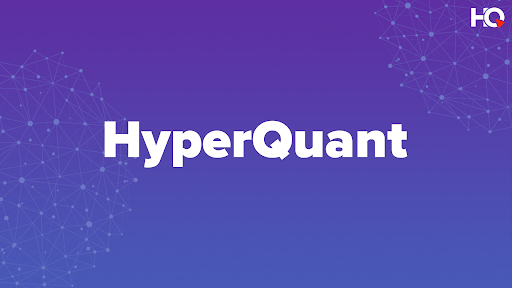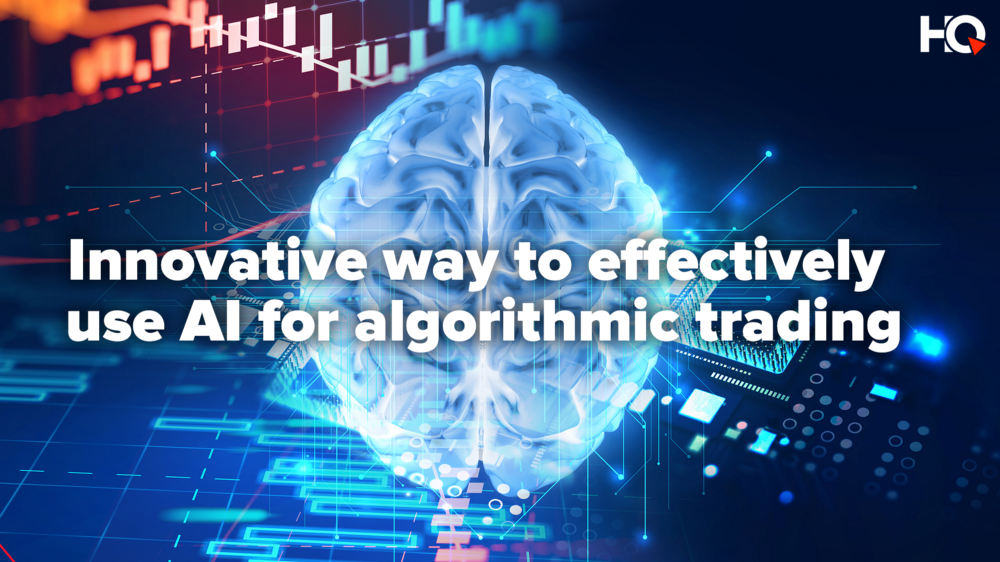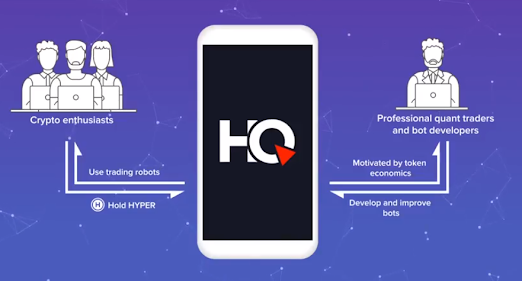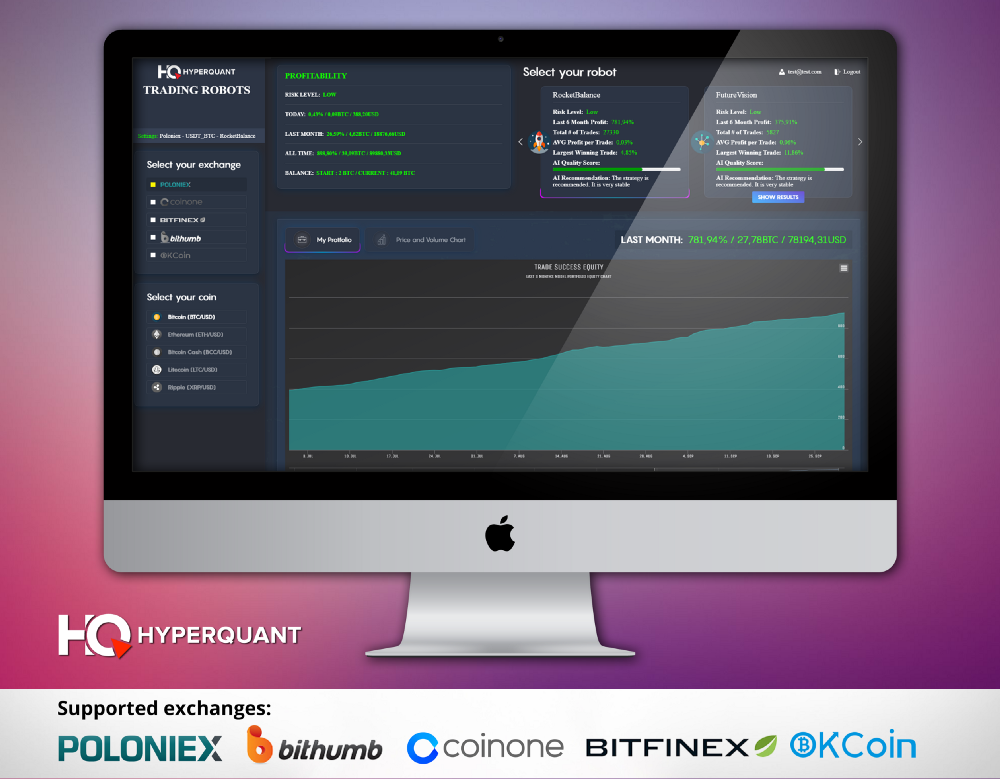.png)
WHAT IS HyperQuant?
HyperQuant Blockchain is a platform for automated investment. With HyperQuant the investment process becomes more simple and transparent for all market players ranging from small investors, big investors, to professional capital managers. HyperQuant is a platform dedicated to the creation of highly effective decentralized financial services. The platform provides new opportunities for software developers and algorithmic trading by providing a quantitative framework reinforced by advanced risk management and blockchain AI technologies that ensure system stability and reliability. HyperQuant implements a smart contract realization mechanism. The HyperQuant system provides utilities for the creation and development of algorithmic trading solutions. AI regulates ranking and artificial intelligence systems that make it possible to manage various platform elements. The HyperQuant application contains services and solutions for retail and corporate system users.

How Do HyperQuant Work?
HyperQuant's business model is based on an innovative approach that determines what's important and necessary for users. The concept of this business model relies on identifying high profit zones, determining methods for gaining market share and ensuring its protection from competitors. HyperQuant ecosystem creates an architecture that makes it possible to turn pioneer technology into actual economic value. Services created in the HyperQuant ecosystem have great potential for growth.

HyperQuant uses trading robots to complete trading operations on financial markets with a set of algorithms. Trading with the help of an algorithmic system has several advantages: to make decisions at maximum speed and to complete trade tasks at speeds that are not available to humans, automatically processing market data and generating trade signals, and trading signal processing accuracy allows to prevent errors by demand settings market.

Trading strategies and models have several classifications :
- Trend Following Strategy:
The main goal of this strategy is to find favorable rates for completing trading operations with the aim of maintaining a profitable position in the longest period of time. Strategies follow the trend of trying to capture the huge fluctuations of financial instruments. A trend-based strategy based on technical indicators is the most popular strategy. Technical indicators are functions based on the values of indicators of statistical exchange, for example, prices of traded instruments. The rules of opening and closing positions in this strategy are shaped by the derivation of indicators and comparative values calculated between themselves as well as the market value. - The Counter-Trend Strategy:
is a strategy based on the expectations of significant price movements and consequent positions opening in the opposite direction. The assumption is that the price will return to its average value. The counter-trend strategy is often attractive for trading because the goal is to buy at the lowest price and sell at the highest price. - Pattern Recognition Strategy:
The purpose of this strategy is to classify objects in different categories. Image recognition tasks in distributing new, recognizable objects to specific classes. Such strategies use neural networks as the basis for education and are widely used for the recognition of candlestick patterns. The candlestick pattern is a particular combination of candlesticks. There are many candlestick models and assumptions about continuous or reverse price movements happening based on the appearance of candlestick models. These assumptions are a strategy based on the introduction of technical analysis. - Arbitrage Strategy:
There are different types of Arbitrage strategies: Cross-Market Arbitrage and Statistical Arbitrage. - Strategy based on machine learning:
The basis of machine learning is the modeling of historical data and the use of models to estimate future prices. One type of machine learning is classification.
Based on that strategy, HyperQuant created a strategy with Si Technologies Algorithm. HyperQuant's Si Technologies Algorithm Strategy is:
- Smart order execution strategy
This strategy class is based on work with orderbook. The HyperQuant software makes it possible to dynamically cite strategies depending on specific tasks.
It is not possible to execute orders at the same price first, all trades will be at the desired price, but gradually the price will become less profitable. To reduce costs, institutional clients need to use the Smart Order execution strategy. The execution of large market orders can be divided into several steps and involves a combination of strategies. Users of the HyperQuant platform will be able to configure specific fields from quotation strategies such as Instrument, Volume, Minimum volume, Maximum volume, Maximum BBO distance, Internal quotation levels, Internal quotation levels, Hedging, Hedging type and Hedging settings. - Market Making Algorithms
The execution of market-making algorithms leads to a boost of liquidity in trading instruments. This also results in lower volatility of trading instruments. Providing liquidity is essential for the development of the trading industry. The mechanism of liquidity provision is widespread in the largest stock markets such as NYSE, NASDAQ, and CME. Market makers must support two-way quotes in orderbook and adhere to some requirements The minimum quotation period and the volume of all orders are bought and sold according to market maker data. - Risk Management
Risk management is the process of adopting and meeting complex actions aimed at reducing the likelihood of unfavorable outcomes and minimizing possible losses. Every trading and investment activity poses certain risks. The risk in this case is the possibility of unexpected financial losses in an uncertain environment. Every trader faces market risk ie the possibility of changes in asset prices due to market exchange rate fluctuations. There are other risks that are rarely known to be operational, functional, selective, and liquidity risks. - Hedging
Hedging can be divided into Selling Hedge and Buying Hedge. Buying Hedge is used when traders plan to buy assets in the future and seek to reduce risks associated with price increases. Selling Hedge is used in the case of a sale in a commodity market to hedge the risk of future price falls, and implies that the seller fixes a fixed price for himself. - AI based Financial Advisor
The majority of investments fail because of incorrect risk management and inadequate control by users. To solve this problem, HyperQuant uses artificial intelligence based on data collected from HyperQuant platform users. - Blockchain based on the Smart Contract Protocol
The HyperQuant team develops an integrated protocol with standard settings for algorithmic strategy portfolios, implemented as smart contracts.
What problems does HyperQuant solve?
.png)
This version includes an automated user’s investment portfolio manager. At the moment it supports parallel operation on 5 major crypto exchanges and with 5 most popular tokens. They have successfully redesigned a main workplace and launched a trading robot selection. There are 5 new strategies with the biggest profitability and they are being traded online right now!

When developing AI systems, aspiring entrepreneurs rarely consider the potential difficulties arising on a real market, especially when their systems need to be scaled. The algorithmic trading vitally requires a correctly built infrastructure for easy access to the exchange systems. This influences both the speed of receiving information online and the routing of the market orders flow to the exchanges.



The infrastructure created by the developers of the HyperQuant project would not be so valuable if it did not allow solving really important and complex problems.
.png)
And there are such problems, and there are many. Here are at least some:
- the lack of transparency of the crypto market - not all users are sure that trading tokens is safe and open;
- lack of control in the transfer of funds to the management - today the funds that manage cryptocurrency investments, do not guarantee that the money will reach them;
- dependence on the investment Fund - the owner of the capital, who transferred the money to the management, can not influence the decisions of managers;
- a small number of profitable strategies - actions that bring results, have long been known, and revolutionary things do not appear on the market.
HyperQuant solves all these problems. The platform allows you to trade through a mobile application and do it as safely and transparently as possible. The money invested in HyperQuant remains under the control of the user - he can withdraw them at any time. Well, the fact that the management of funds is carried out by a computer, not a person, causes a variety of asset management, which ordinary people often can not oppose anything.
Alpha Version Release
This version includes an automated user’s investment portfolio manager. At the moment it supports parallel operation on 5 major crypto exchanges and with 5 most popular tokens. They have successfully redesigned a main workplace and launched a trading robot selection. There are 5 new strategies with the biggest profitability and they are being traded online right now!

HyperQuant is a smart home for AI based prediction systems
When developing AI systems, aspiring entrepreneurs rarely consider the potential difficulties arising on a real market, especially when their systems need to be scaled. The algorithmic trading vitally requires a correctly built infrastructure for easy access to the exchange systems. This influences both the speed of receiving information online and the routing of the market orders flow to the exchanges.
HyperQuant Benefits
The main advantage of HyperQuant, due to which the developers plan to win the competition - fully automated investment. This is a very important advantage: it gives the opportunity to invest in tokens and earn even those people who do not understand anything in investments. It is enough to set how much you need to earn and what risk is acceptable, and the platform will do everything on its own.
It is also important that HyperQuant allows participants to develop trading bots “for themselves”. Sites where you can do quite a bit, and HyperQuant is one of them.
ICO and token distribution
To conduct the ICO, the developers of HyperQuant created the HQT token.
In total, 320 million HQT tokens will be issued, which will be sold in two stages in may and June 2018. For 1 ETH during the main round of crowdsale HyperQuant you can buy 3500 HQT.
Minimum target ICO HyperQuant (SoftCap) - 5000 ETH. HardCap - 41143 ETH.
The investments collected on the ICO will be distributed as follows:
Token Sale Details


TEAM
The HyperQuant team consists of 11 team members and 4 advisors.
The founding team is made up of quant traders, IT professionals, and market analysts.
According to CEO and co-founder Pavel Pavchenko, creating the HyperQuant platform was a direct result of the team’s combined experience. Pavchenko himself has more than 14 years’ experience as a successful trader. He has worked in investment companies as an independent quantitative trader, managed a large hedge fund and even took part in the creation of Russia’s second largest stock exchange.
ROADMAP

ETH: 0x37B6953a3D9c40D5e40Dfc7DA2B8A58223b2a583
Komentar
Posting Komentar